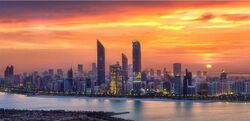Jangsan
Jangsan | |
|---|---|
City | |
| City of Jangsan | |
 Skyline of Jangsan's central business district in the northern banks of the Heuksu River. | |
|
Flag of Jangsan Flag | |
| Jangsan founded | June 4, 1881 |
| District Division | Prefecture of Jangsan |
| Government | |
| • Type | Jangsan Municipal Assembly |
| • Elected body | Jangsan Municipal Assembly |
| • Mayor | June Choi (N) |
| • Representative | 5 Representatives |
| Area | |
| • Total | 557.5 km2 (215.3 sq mi) |
| • Land | 536.3 km2 (207.1 sq mi) |
| • Water | 21.2 km2 (8.2 sq mi) |
| Highest elevation | 311.1 m (1,020.7 ft) |
| Lowest elevation | 141.5 m (464.2 ft) |
| Population (2019) | |
| • Total | 1,287,779 |
| • Density | 2,309.9/km2 (5,983/sq mi) |
| Demonym | Jangsanese/Jangsaner |
| Time zone | UTC+07:00 (Zhenia Western Standard Zone (ZEST)) |
| ZIP Code | 32001-32015 |
| Zhenia Federal Area Code | 075 |
| City Flower | Jangsan Cactus |
| City Tree | Heuksu Tree |
| Website | www.cityofjangsan.zhen.gov |
Jangsan (Classic Zhenian: 萇山, Modern Zhenian: 장산), formally the City of 'Jangsan (Classic Zhenian: 萇山市, Modern Zhenian: 장산시), is the provincial capital and most populous city in Heuksu Province, the westernmost province-level administrative area in the nation. Located at the northern bank of the Heuksu River and at the southern parts of the province, it is home to almost 1.3 million residents as of 2019 while its metropolitan area is home to over 4 million residents.
Officially settled as a stopping point for miners heading to gold mines in the Sancheon Mountains in the late 19th century, it was formally incorporated in 1881 by Zhenian settlers. Since then, it has experienced a boom in economic growth in the 20th century with the overall development in Heuksu Province, with additional booms in irrigation farming, as well as petroleum and natural gas extraction in the area, with the population skyrocketing from a mere 50,000 in 1900 to over 1 million in 1999. It remains one of the fastest-growing cities in the nation by population even into the 21st century, a trend that will continue with additional development of petroleum and natural gas.
